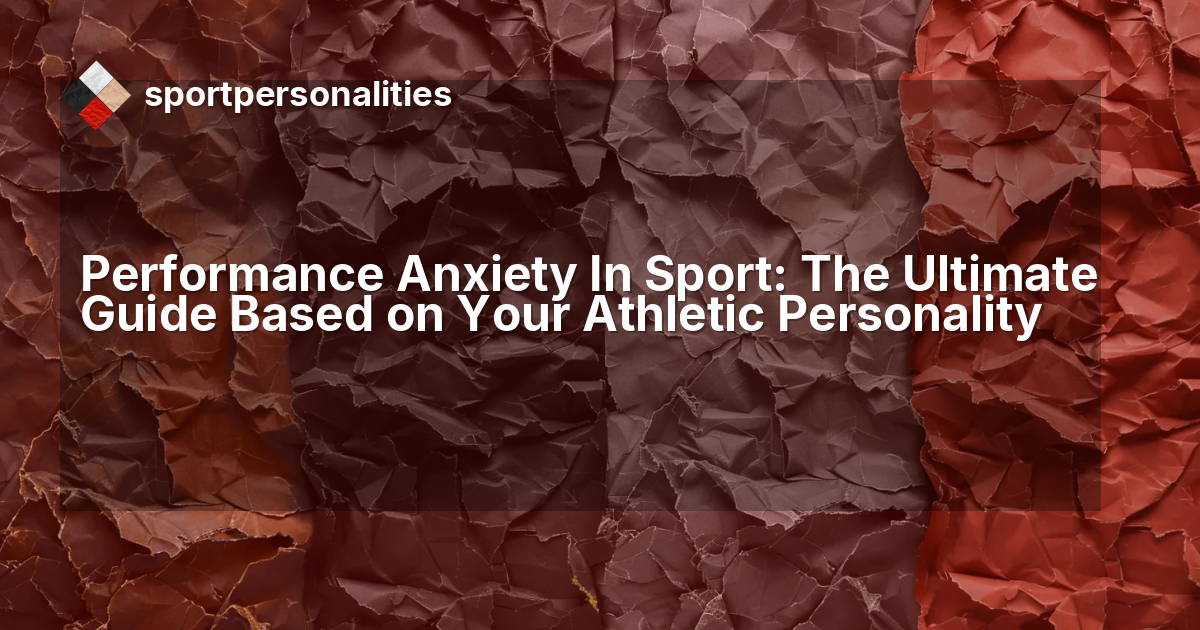Performance Anxiety in Sports: The Ultimate Guide Based on Your Athletic Personality
- Physical symptoms: racing heart, sweating, trembling, dry mouth, nausea, dizziness, muscle tension, fast or shallow breathing
- Mental symptoms: catastrophizing, self-doubt, negative self-talk, attention lapses, fear of failure or embarrassment
- Behavioral symptoms: pre-game avoidance, conservative play, unforced errors, disturbed sleep, withdrawal from team roles
Find Your Sport Personality
Take the free SportDNA Assessment to uncover which of the 16 athletic profiles best matches your motivation, mindset, and competitive style.
Start NowHow Performance Profiling Helps Athletes Manage Anxiety
Performance profiling, sometimes called behavioral profiling for athletes, is the process of mapping how psychological tendencies influence performance under pressure. It helps athletes identify which mental, emotional, and behavioral factors drive their best and worst moments. In sport psychology, a performance profile acts as a personalized diagnostic map—revealing how motivation, cognitive focus, and social context interact to shape competitive behavior.
Within the SportPersonalities framework, performance profiling means understanding your Four Pillars—Drive, Competitive Style, Cognitive Style, and Social Style. This profiling process transforms abstract psychology into practical insight, showing you why certain anxiety triggers appear and which regulation strategies will actually work for you.
In short, performance profiling turns “managing nerves” into a structured self-awareness tool, converting anxiety from a vague emotional reaction into measurable, coachable data.
Understanding Performance Anxiety and Performance Profiling: The Foundation
The goalkeeper stands frozen on the penalty spot. Her palms are slick with sweat. Her vision narrows to a tunnel. The crowd noise becomes a roar, then a hum, then nothing at all. This is performance anxiety in sport—a psychological state that transforms capable athletes into hesitant performers, turning routine actions into monumental challenges. For decades, sport psychology has approached this phenomenon with generic solutions: breathing exercises, positive self-talk, visualization protocols. These techniques help, but they miss something fundamental. Performance anxiety doesn't manifest the same way in every athlete because athletes themselves are fundamentally different.
Performance anxiety in sport represents more than simple nervousness before competition. It's a complex interaction between physiological arousal, cognitive appraisal, and behavioral response that varies dramatically based on an athlete's psychological makeup. Research shows these symptoms affect performance differently depending on individual characteristics. The same elevated heart rate that paralyzes one athlete might energize another. The internal dialogue that crushes one competitor's confidence might sharpen another's focus.
Traditional sport psychology treats anxiety as a universal problem requiring standardized solutions. The SportPersonalities framework reveals a more nuanced reality. Athletes process competitive pressure through distinct psychological lenses shaped by four fundamental dimensions: how they think during competition, what they compete against, what motivates their pursuit, and how they interact with their performance environment. Understanding these dimensions transforms performance anxiety management from a one-size-fits-all approach into a personalized strategy that works with an athlete's natural tendencies rather than against them.
Consider two basketball players facing championship game pressure. The first thrives on meticulous preparation, having studied opponent tendencies for weeks, finding comfort in her strategic analysis. The second trusts split-second instincts, reading defensive adjustments in real time without conscious deliberation. Standard anxiety management protocols might teach both players identical breathing techniques. A personality-informed approach recognizes that the first athlete needs strategies that preserve her analytical edge under pressure, while the second requires methods that maintain her reactive flow state. This distinction separates effective anxiety management from generic coping mechanisms.
The Four Pillars of Personality and Behavioral Profiling in Sport
The SportPersonalities framework identifies four psychological dimensions that fundamentally shape how athletes experience and respond to competitive pressure. These pillars don't simply describe personality traits—they reveal the underlying mechanisms through which performance anxiety manifests and can be managed. Most athletes show clear preferences on each dimension, but personality exists on a spectrum, not in boxes. You might be strongly tactical but only moderately autonomous. Or you might shift from intrinsic to extrinsic motivation depending on the competitive context. Use these profiles as starting points for self-exploration, not rigid labels.
Drive: The Fuel Behind Your Pressure Response
Intrinsically motivated athletes find fulfillment through the inherent satisfaction within athletic experience itself. They pursue sport for movement joy, mastery satisfaction, and personal meaning. Performance anxiety for these athletes often emerges when external stakes or evaluative pressure disrupts their internal focus. An intrinsically driven rock climber who loves the problem-solving aspect of difficult routes might experience unusual anxiety in a formal judged competition, not because intrinsic athletes can’t handle pressure, but because the evaluative context momentarily misaligns with their natural motivation. When meaning is preserved—such as reframing competition as a personal challenge—these athletes can perform at their absolute best.
Extrinsically motivated athletes derive energy from external rewards, recognition, and tangible achievements. Evaluative pressure often activates their optimal performance zone. However, these athletes can experience intense anxiety when external stakes feel overwhelming or when past failures create fear of public judgment. An extrinsically driven sprinter might thrive on qualifying round pressure but experience paralyzing anxiety in Olympic finals where global scrutiny intensifies exponentially.
The critical application: intrinsically motivated athletes manage anxiety by reconnecting with their love of the activity itself, stripping away external evaluation temporarily to restore natural engagement. Extrinsically motivated athletes benefit from reframing external pressure as energizing rather than threatening, transforming evaluation from burden to opportunity.  The Flow-Seeker (ISRA) and
The Flow-Seeker (ISRA) and  The Gladiator (EORA) require fundamentally different pre-competition mental preparation because their motivational engines respond to pressure through opposite mechanisms.
The Gladiator (EORA) require fundamentally different pre-competition mental preparation because their motivational engines respond to pressure through opposite mechanisms.
Competitive Style: What You're Really Anxious About
Self-referenced athletes measure success through personal progression and individual excellence. They compete against their own standards and untapped potential. Performance anxiety for these athletes centers on fear of failing to execute their capabilities—the internal disappointment of not meeting self-imposed standards. A self-referenced marathon runner feels most anxious not about competitors but about potentially missing a goal pace that represents months of training progression.
Other-referenced athletes define success through direct comparison and victory over opponents. Performance anxiety for these competitors revolves around defeat and competitive positioning. The same marathon runner, if other-referenced, experiences anxiety primarily about being outperformed by rivals or dropping in competitive rankings. This fundamental difference means that identical situations generate completely different anxiety triggers based on competitive style.
Understanding this distinction revolutionizes anxiety management. Self-referenced athletes need strategies that refocus attention on controllable execution factors rather than outcomes. Other-referenced athletes benefit from reframing competition as opportunity rather than threat, channeling their comparison-driven nature productively.  The Purist (ISTA) manages performance anxiety differently than
The Purist (ISTA) manages performance anxiety differently than  The Rival (EOTA) because their psychological relationship to competition operates through entirely different mechanisms.
The Rival (EOTA) because their psychological relationship to competition operates through entirely different mechanisms.
Cognitive Style: How Performance Anxiety in Sports Affects Your Mental Game
Tactical athletes approach competition through systematic analysis and detailed planning. Their confidence emerges from thorough preparation and strategic foresight. Performance anxiety for these athletes typically manifests as paralysis through over-analysis—the tendency to second-guess predetermined strategies when pressure intensifies. A tactical tennis player who has meticulously studied an opponent's serving patterns might suddenly question her game plan during a tiebreaker, leading to hesitation and missed opportunities.
Reactive athletes navigate competition through instinctive adaptation and real-time problem-solving. They excel at reading emerging patterns without conscious deliberation. For these athletes, performance anxiety often appears as a disruption to their natural flow. A reactive point guard who normally makes brilliant passes without thinking might suddenly become too conscious of his decisions under championship pressure, transforming effortless play into mechanical execution. Research in sport psychology confirms that self-consciousness represents one of the primary mechanisms through which anxiety impairs reactive performance.
The key insight: anxiety management strategies must align with cognitive style. Tactical athletes benefit from pre-competition routines that reinforce strategic preparation, creating psychological anchors when doubt emerges. Reactive athletes need techniques that restore automatic processing, returning them to the instinctive state where they perform best. Generic anxiety protocols that ignore these differences often prove ineffective or even counterproductive.
Social Style: Your Performance Environment Under Pressure
Autonomous athletes thrive on independence and self-direction. They process information privately and maintain strong internal regulation. Performance anxiety for these athletes can intensify when forced into collaborative settings or when coaching input feels intrusive during high-pressure moments. An autonomous triathlete who has developed precise race pacing through solo training might experience heightened anxiety when team coaches provide conflicting advice in the transition area during championship competition.
Collaborative athletes thrive in interconnected environments where shared energy enhances performance. They draw motivation from training partners, coaches, and athletic community. These athletes often experience performance anxiety when isolated or when team dynamics fracture. A collaborative volleyball player who normally feeds off teammate energy might struggle with unusual anxiety when team chemistry deteriorates heading into playoffs, as her primary support system becomes a source of stress rather than strength.
Strategic application requires acknowledging these social preferences. Autonomous athletes need pre-competition routines that provide solitary processing time and clear boundaries around external input. Collaborative athletes benefit from structured team connection rituals and explicit reassurance of social support.  The Anchor (ISTC) and
The Anchor (ISTC) and  The Daredevil (ESRA) experience performance anxiety differently not because of their competitive style—both are self-referenced—but because their drive and social style create opposite environmental pressures. The Anchor’s intrinsic, collaborative nature finds security in team cohesion, while the Daredevil’s extrinsic, autonomous profile thrives on independence and stimulation. Their anxiety patterns diverge because one depends on connection, the other on freedom.
The Daredevil (ESRA) experience performance anxiety differently not because of their competitive style—both are self-referenced—but because their drive and social style create opposite environmental pressures. The Anchor’s intrinsic, collaborative nature finds security in team cohesion, while the Daredevil’s extrinsic, autonomous profile thrives on independence and stimulation. Their anxiety patterns diverge because one depends on connection, the other on freedom.
Cognitive Style
Tactical: over-analysis, second-guessing under pressure.
Reactive: disrupted flow, self-conscious decision-making.
Competitive Style
Self-referenced: fear of not meeting personal standards.
Other-referenced: fear of defeat and rankings.
Drive
Intrinsic: evaluation disrupts joy/mastery focus.
Extrinsic: scrutiny energizes until it overwhelms.
Social Style
Autonomous: intrusive input increases anxiety.
Collaborative: isolation/fractured chemistry elevates anxiety.
Personality-Based Approaches to Performance Anxiety in Sports
Generic anxiety management protocols fail because they ignore the psychological architecture through which athletes process competitive pressure. The SportPersonalities framework reveals that effective strategies must align with an athlete's natural cognitive processing, competitive orientation, motivational drivers, and social preferences. Here's how specific sport profiles can develop personalized approaches to managing performance anxiety in sport.
The Purist (ISTA): Preserving the Love Under Pressure
The Purist combines intrinsic motivation with tactical thinking, self-referenced standards, and autonomous operation. This athlete finds profound fulfillment in athletic expression itself, approaching sport with the dedication of a scholar and heart of a true believer. Performance anxiety for The Purist typically emerges when external evaluation disrupts their internal focus or when competitive pressure makes them forget why they love their sport.
Effective anxiety management for this sport profile centers on reconnection with intrinsic values. Before high-stakes competitions, The Purist benefits from journaling about what they love most about their sport—the specific sensations, challenges, or moments that originally drew them to the activity. During competition, when anxiety threatens to overwhelm, they can use brief mental check-ins that redirect attention from external evaluation back to internal experience: "What do I notice in my body right now? What subtle adjustments feel right?"
Because the Purist is both intrinsically driven and self-referenced, they calm anxiety by reconnecting with personal meaning (Drive) and precise technical execution (Competitive Style). Instead of outcome goals, use process cues that anchor attention to form and timing.
Instead of goal-setting around results, they might identify three technical elements to focus on during different competition phases. This approach satisfies their need for strategic preparation while maintaining alignment with self-referenced, intrinsically motivated orientation. Research on process goals confirms they reduce performance anxiety more effectively than outcome goals for athletes with similar psychological profiles.
 The Captain (EOTC): Channeling Leadership Energy
The Captain (EOTC): Channeling Leadership Energy
The Captain represents the natural-born leader who thrives at the intersection of strategic thinking and team dynamics. Driven by external recognition and competitive fire, this sport profile transforms individual talent into collective triumph. Performance anxiety for The Captain often manifests as over-responsibility for team outcomes or fear of letting down teammates who depend on their leadership.
This sport profile's anxiety management strategy should harness their tactical and collaborative strengths. Pre-competition routines might include structured team meetings where The Captain articulates strategic priorities, transforming nervous energy into purposeful preparation. Their other-referenced focus channels attention toward strategic competition, while their extrinsic drive converts public stakes into purpose. The more they define pressure as opportunity for leadership display rather than judgment, the calmer they perform.
During competition, The Captain manages pressure by actively engaging leadership responsibilities. Calling timeouts to organize teammates, communicating tactical adjustments, or providing encouragement to struggling players gives them constructive outlets for anxious energy. Their extrinsic motivation means they should embrace rather than fight the importance of external stakes, reframing high-pressure moments as opportunities to demonstrate leadership capabilities. Sport psychology research on leadership and anxiety suggests that task-focused communication reduces personal anxiety while simultaneously improving team performance.
 The Maverick (IORA): Trusting the Instinct
The Maverick (IORA): Trusting the Instinct
The Maverick represents independent athletic excellence driven by internal fire that burns regardless of external validation. This sport profile thrives in direct competition while maintaining autonomous nature, writing their own playbook through reactive instincts and spontaneous brilliance. Performance anxiety for The Maverick typically appears as over-thinking that disrupts their natural reactive flow or as pressure to conform to conventional approaches that conflict with their autonomous identity.
Anxiety management for this sport profile requires protecting their reactive processing style. Pre-competition routines should be minimal and flexible rather than rigid and detailed, allowing The Maverick to remain in a responsive rather than predetermined mindset. They might use brief physical warm-up sequences that prime instinctive movement patterns rather than extensive mental rehearsal that encourages analytical thinking.
During competition, The Maverick benefits from permission-granting self-talk that reinforces their autonomous identity: "Trust your read. Play your game. Nobody else can do what you do." While the Maverick’s anxiety stems from disrupted flow and over-analysis, their other-referenced nature helps them re-engage by treating the opponent as a stimulus for focus rather than a threat to avoid. The key is keeping focus external and reactive rather than internal and analytical. When anxiety threatens to disrupt flow, physical reset routines—aggressive body language, explosive movements, or brief isolation from external input—help restore their natural reactive state.
 The Sparkplug (ESRC): Converting Pressure into Energy
The Sparkplug (ESRC): Converting Pressure into Energy
The Sparkplug transforms pressure into performance through natural ability to thrive in chaotic, high-stakes moments while simultaneously elevating teammates. They pursue external recognition through internal mastery, creating powerful synergy between individual excellence and team success. Performance anxiety for this sport profile can emerge when pressure becomes overwhelming rather than energizing or when their role as team energizer creates unsustainable emotional demands.
This sport profile's anxiety management leverages their collaborative and reactive nature. Pre-competition routines should involve high-energy team activities—dynamic warm-ups with music, group celebrations of past successes, or playful competitive drills that generate positive arousal. The Sparkplug thrives on controlled chaos, so structured anxiety reduction might actually backfire by lowering arousal below their optimal zone.
During competition, The Sparkplug manages anxiety by actively engaging with teammates and embracing the moment's intensity. Their self-referenced competitive style keeps anxiety manageable when they focus on executing their role rather than rival outcomes, while their extrinsic drive channels the crowd and team energy into productive intensity instead of overwhelm. When anxiety threatens to tip into overwhelm, brief grounding techniques that acknowledge the pressure while reframing it as fuel can be effective: "This intensity means it matters. This is exactly where I want to be." Their extrinsic motivation means they should visualize the external rewards and recognition that successful performance will bring, using these images to convert nervous energy into motivated action.
Common Challenges with Performance Anxiety in Sports and Solutions
Athletes and coaches frequently encounter obstacles when implementing anxiety management strategies. Understanding how personality influences these challenges reveals why generic solutions often fail and how personality-aware approaches provide superior results.
The Preparation Paradox
Many athletes believe more preparation reduces anxiety. For tactical athletes, additional strategic preparation often does create confidence through thorough readiness. However, for reactive athletes, excessive preparation can generate anxiety by encouraging over-thinking that disrupts instinctive processing. A reactive soccer player who studies hours of opponent footage might enter the match mentally cluttered, unable to trust the split-second reads that normally drive her best performances.
The personality-aware solution recognizes that optimal preparation intensity varies by cognitive style. Tactical athletes should lean into comprehensive preparation as an anxiety management tool, while reactive athletes need permission to prepare less analytically and more experientially. Coaches working with reactive athletes might replace film study with reactive drills that prime instinctive responses without encouraging analytical processing. This personalized approach to preparation intensity represents a competitive advantage that generic protocols miss entirely.
The Isolation Question
Standard pre-competition advice often recommends isolated focus time. For autonomous athletes, this solitary preparation allows essential mental processing and emotional regulation. However, collaborative athletes can experience increased anxiety when isolated from their support network during high-pressure periods. A collaborative track athlete quarantined alone in a hotel room before Olympic trials might experience escalating anxiety specifically because she's disconnected from the teammates and coaches who normally provide emotional grounding.
The solution requires acknowledging social style differences. Autonomous athletes should protect solitary preparation time, establishing clear boundaries against well-meaning but intrusive social demands. Collaborative athletes should structure pre-competition routines that include meaningful connection with their support system—team meals, partner workouts, or coach check-ins that provide social regulation before isolation becomes necessary. Sport psychology research confirms that social support effectiveness varies by personality, with some athletes benefiting substantially while others showing no effect or even performance decrements.
The Motivation Mismatch
Coaches frequently attempt to motivate athletes through external incentives or internal meaning, depending on the coach's own motivational orientation rather than the athlete's psychological makeup. An intrinsically motivated distance runner pushed to focus on podium finishes and ranking points might experience increased anxiety as these external frames conflict with her natural joy-of-movement motivation. Conversely, an extrinsically motivated sprinter told to "just have fun out there" might feel dismissed and unsupported when she needs acknowledgment of the stakes and external significance.
Personality-aware solutions require matching motivational language to athlete drive. Intrinsically motivated athletes manage anxiety through reconnection with their love of the activity itself, with coaches helping them strip away external evaluation temporarily. Extrinsically motivated athletes benefit from explicit acknowledgment of stakes and importance, with coaches helping them view external pressure as energizing opportunity rather than threatening burden. This motivational alignment transforms pre-competition communication from generic encouragement into precisely targeted psychological support.
Building Your Personal Performance Anxiety in Sports Strategy
Developing an effective anxiety management approach requires understanding your unique psychological profile and building strategies that work with your natural tendencies rather than against them. Here's a systematic process for creating personalized protocols.
- Identify your psychological profile. Map your Four Pillars: cognitive (tactical vs. reactive), competitive (self- vs. other-referenced), drive (intrinsic vs. extrinsic), social (autonomous vs. collaborative).
- Analyze your anxiety triggers. List situations, thoughts, and sensations that precede your toughest moments under pressure.
- Design personality-aligned interventions. Choose techniques that fit your profile and avoid mismatched strategies.
- Practice under progressive pressure. Test in low-stakes settings and increase intensity as strategies stabilize.
- Build competition-day protocols. Script timing and actions for the night before, morning of, warm-up, and in-competition resets.
Step One: Identify Your Psychological Profile
Begin by honestly assessing your position on each of the Four Pillars. For cognitive style, consider whether you typically prepare through detailed strategic analysis or trust instinctive adaptation during competition. For competitive style, examine whether you measure success primarily against personal standards or through comparison with opponents. For drive, reflect on whether you find fulfillment mainly through the activity itself or through external rewards and recognition. For social style, notice whether you perform best with independence or through collaborative connection.
Most athletes show clear preferences on each dimension, though some might identify middle-ground positions. The goal isn't perfect categorization but rather honest self-awareness about your natural psychological tendencies. Athletes often discover that past anxiety management failures resulted from strategies misaligned with their actual personality rather than insufficient effort or commitment.
A word of caution: These profiles describe tendencies, not destinies. You're not searching for the 'right' box to fit into—you're identifying patterns that help explain your unique anxiety responses. If you're 60% tactical and 40% reactive, that matters. If you're intrinsically motivated in training but extrinsically motivated in competition, that's valuable information. The goal is self-awareness, not perfect classification. Let the framework illuminate your patterns without constraining your complexity.
Step Two: Analyze Your Anxiety Triggers
With personality awareness established, examine the specific situations that generate performance anxiety for you. Tactical athletes often experience heightened anxiety when preparation time is limited or when facing unfamiliar opponents. Reactive athletes typically struggle when forced to follow rigid game plans or when their instinctive flow gets disrupted. Self-referenced athletes feel most anxious about failing to meet personal standards. Other-referenced athletes experience primary anxiety around defeat and competitive positioning.
Create a detailed anxiety trigger inventory, noting the specific circumstances, thoughts, and physical sensations that accompany your most challenging pressure moments. The more specifically you identify your unique anxiety patterns, the more precisely you can develop targeted interventions. Research on anxiety management consistently demonstrates that personalized, trigger-specific strategies outperform generic protocols.
Step Three: Design Personality-Aligned Interventions
Build your anxiety management toolkit by selecting techniques that align with your psychological profile. Tactical athletes should develop comprehensive pre-competition planning routines that include strategic contingencies, creating confidence through thorough preparation. Reactive athletes need physical and mental routines that prime instinctive responses while preventing analytical over-thinking.
Self-referenced athletes benefit from process-focused goals that direct attention toward controllable execution factors rather than competitive outcomes. Other-referenced athletes should develop reframing techniques that transform opponent comparison from threat to opportunity, channeling their competitive nature productively. Intrinsically motivated athletes require strategies that reconnect them with their love of the activity when external pressure threatens to overwhelm. Extrinsically motivated athletes need methods that acknowledge stakes while preventing external evaluation from becoming paralyzing.
Autonomous athletes should create pre-competition routines that provide necessary solitary processing time and clear boundaries around external input. Collaborative athletes benefit from structured connection rituals with coaches, teammates, or support networks that provide social regulation before isolation becomes necessary.
Step Four: Practice Under Progressive Pressure
Anxiety management skills require deliberate practice under gradually increasing pressure. Begin implementing your personality-aligned strategies in low-stakes training environments where experimentation carries minimal risk. A tactical athlete might practice new pre-competition planning routines before regular season matches rather than championship finals. A reactive athlete could work on flow-maintenance techniques during practice scrimmages before high-stakes tournament games.
Progressive exposure to pressure allows you to refine interventions based on actual experience rather than theoretical assumptions. Athletes often discover that certain techniques work better than others, or that specific triggers require more sophisticated responses than initially developed. This iterative refinement process represents the difference between having anxiety management strategies and having proven, reliable protocols you trust completely when pressure intensifies.
Step Five: Build Competition-Day Protocols
Transform your personality-aligned strategies into concrete competition-day protocols with specific timing and implementation details. Create structured routines for the night before competition, morning preparation, pre-competition warm-up, and in-competition pressure moments. The more specific your protocols, the easier they become to implement when anxiety threatens to overwhelm cognitive resources.
Tactical athletes might develop detailed hourly schedules that include strategic review sessions, equipment preparation, and contingency planning. Reactive athletes should create minimal, flexible routines that maintain readiness without encouraging over-thinking. Collaborative athletes need protocols that include structured team connection points. Autonomous athletes require routines that protect necessary solitary processing time.
Write these protocols down explicitly, rehearse them mentally, and practice them physically during training. When championship pressure arrives, you won't need to remember what to do because the protocols will be deeply ingrained through systematic practice.
Advanced Performance Anxiety in Sports Applications by Personality Type
Understanding personality doesn't replace traditional sport psychology techniques—it enhances their effectiveness by revealing which interventions work best for specific psychological profiles and how to customize implementation for maximum impact.
Breathing and Physiological Regulation
Controlled breathing represents one of the most research-supported anxiety management techniques. However, implementation should vary by cognitive and social style. Tactical athletes benefit from structured breathing protocols with specific counts and patterns, satisfying their preference for systematic approaches. They might use box breathing—four counts inhale, four hold, four exhale, four hold—with precise timing that appeals to their analytical nature.
Reactive athletes need simpler, less structured breathing cues that don't disrupt instinctive processing. They might use brief exhale resets—sharp exhale, natural inhale—that restore physiological balance without encouraging analytical thinking. Autonomous athletes should practice breathing techniques in solitude, developing internal regulation that doesn't depend on external guidance. Collaborative athletes might incorporate synchronized breathing exercises with teammates, leveraging social connection for physiological regulation.
Visualization and Mental Rehearsal
Mental imagery powerfully impacts performance anxiety, but optimal visualization content varies by competitive style (self- vs. other-referenced) and drive orientation (intrinsic vs. extrinsic). Self-referenced athletes should visualize perfect technical execution and personal best performances, reinforcing their internal standards and process focus. Other-referenced athletes benefit from visualizing successful head-to-head competition against specific opponents, channeling their comparison-driven nature productively.
Intrinsically motivated athletes might visualize the physical sensations and movement quality they love most about their sport, reconnecting with their pure enjoyment. Extrinsically motivated athletes should visualize podium moments, record acknowledgments, and external recognition that reward successful performance, using these images to convert anxiety into motivated action. Tactical athletes typically benefit from extensive mental rehearsal of strategic contingencies. Reactive athletes need less detailed visualization that primes general readiness without encouraging over-planning.
Self-Talk and Cognitive Restructuring
Internal dialogue profoundly influences anxiety, but effective self-talk content depends on psychological profile. Tactical athletes benefit from structured self-talk that reinforces strategic preparation: "I've prepared for every scenario. I'm ready for whatever happens." Reactive athletes need permission-granting statements that protect instinctive flow: "Trust your read. Let it happen."
Self-referenced athletes should use self-talk that refocuses attention on controllable processes: "Execute your race. Run your plan." Other-referenced athletes benefit from competitive challenge statements: "This is what you train for—the chance to compete against the best."
These two sets operate on distinct axes—Competitive Style (Self vs. Other) determines the target of self-talk, while Drive (Intrinsic vs. Extrinsic) shapes its emotional tone.
Intrinsically motivated athletes might use meaning-focused self-talk: "Remember why you love this." Extrinsically motivated athletes can employ recognition-focused statements: "This is your moment to show what you can do."
The key insight: self-talk effectiveness depends on alignment with natural psychological tendencies. Generic positive affirmations often fail because they don't match an athlete's actual cognitive processing, competitive orientation, or motivational drivers. Personality-informed self-talk speaks directly to an athlete's psychological architecture, making messages more believable and therefore more effective under pressure.
The Gladiator (EORA): Harnessing Controlled Aggression
The Gladiator embodies the Other-Referenced, Extrinsic, Reactive, and Autonomous profile—a competitor who thrives on the intensity of direct confrontation. For this sport profile, performance anxiety arises when the fight loses personal meaning or when aggression turns into tension. Their anxiety management focuses on channeling arousal into tactical aggression without emotional overflow. Pre-competition visualization should emphasize control, precision, and readiness rather than rage or domination. Grounding through brief exhalation resets and confident body language helps maintain composure while preserving combat intensity. The Gladiator performs best when anxiety transforms into sharpened alertness—turning threat into target.
Pre-Performance Routines
Structured pre-performance routines reduce anxiety by creating familiar preparation sequences that signal readiness. However, optimal routine length and content vary dramatically by personality. Tactical athletes thrive with comprehensive routines that might extend over days, including detailed strategic review, equipment preparation, venue familiarization, and contingency planning. These extensive routines create confidence through thorough readiness.
Reactive athletes need minimal routines that maintain flexibility and prevent over-thinking. Their pre-performance preparation might focus on physical priming through dynamic movement rather than mental rehearsal, keeping them in a responsive rather than analytical state. Collaborative athletes should build connection rituals into their routines—team huddles, partner warm-ups, or coach check-ins. Autonomous athletes require routines that protect solitary processing time and clear boundaries against external interruption.
The SportPersonalities framework reveals that routine effectiveness depends not on following sport psychology best practices but on matching protocols to individual psychological architecture. What works brilliantly for The Captain might generate anxiety for The Flow-Seeker. Personalized routines represent a significant competitive advantage that generic approaches cannot provide.
Conclusion: Mastering Performance Anxiety in Sports Through Personalization
Performance anxiety in sports will always exist wherever athletes face meaningful competition. The difference between those who crumble under pressure and those who thrive lies not in superior mental toughness or greater competitive desire but in the alignment between anxiety management strategies and individual psychological architecture. Generic sport psychology protocols fail not because the underlying techniques are flawed but because they ignore the fundamental reality that athletes process competitive pressure through distinctly different psychological lenses.
The SportPersonalities framework provides what traditional approaches cannot: a systematic method for understanding individual differences and developing truly personalized anxiety management strategies. When The Purist learns to reconnect with intrinsic love under external pressure, when The Captain channels leadership responsibility into purposeful action, when The Maverick receives permission to trust instinct over convention, when The Sparkplug converts intensity into fuel—these represent more than anxiety management tactics. They reflect deep alignment between intervention and identity, between strategy and psychology, between technique and truth.
Athletes spend thousands of hours developing physical capabilities. They analyze technique frame-by-frame, optimize nutrition to the gram, and track recovery metrics obsessively. Yet many approach psychological preparation with generic protocols designed for a mythical average athlete rather than their actual psychological reality. This represents not just a missed opportunity but a competitive disadvantage against opponents who understand and leverage their unique psychological architecture.
In practice, this personalization begins with understanding your Four Pillars—Drive, Competitive Style, Cognitive Style, and Social Style—which together form the architecture of your Sport Personality Profile. Each pillar reveals a different lever for transforming anxiety from interference into insight. As sport psychology evolves beyond standardized interventions toward individual-specific strategies, frameworks that systematically account for personality differences will separate progressive programs from outdated approaches. Athletes and coaches who embrace this personality-informed perspective don't just manage anxiety better—they transform pressure from obstacle into opportunity, from threat into advantage, from weakness into strength.
Understanding your psychological profile through the Four Pillars framework—your cognitive style, competitive style, drive, and social style—provides the foundation for developing anxiety management strategies that actually work for you rather than for some theoretical average athlete. Whether you identify with The Anchor's collaborative stability, The Daredevil's reactive glory-seeking,  The Duelist (IOTA)'s tactical brilliance, or any of the other sport profiles, your path to mastering performance anxiety in sports begins with honest self-awareness and continues through personality-aligned strategy development.
The Duelist (IOTA)'s tactical brilliance, or any of the other sport profiles, your path to mastering performance anxiety in sports begins with honest self-awareness and continues through personality-aligned strategy development.
The athletes who dominate the next decade won't simply be the most physically talented or the most mentally tough. They'll be the ones who understand their psychological architecture well enough to build personalized performance systems that work with their nature rather than against it. They'll transform competitive pressure from a force that diminishes performance into fuel that ignites their best efforts. They'll discover that anxiety management isn't about eliminating nervousness but about channeling it precisely according to their unique psychological design.
Your competitive advantage waits in the space between generic advice and personalized strategy, between standardized protocols and individual truth, between who sport psychology thinks you should be and who you actually are. Discover your sport profile. Understand your pillars. Build your personalized approach to managing performance anxiety in sports. The difference between good and great often comes down to this: knowing yourself well enough to prepare yourself properly for the moments that matter most.
References
- Niering, M., Krause, A., Scharinger, C., & Mirea, N. (2023). Effects of psychological interventions on performance anxiety in performing artists and athletes: A systematic review with meta-analysis. Behavioral Sciences, 13(6), 460. https://doi.org/10.3390/bs13060460
- Ren, P., Song, T., Chi, L., Wang, X., & Miao, X. (2022). The adverse effect of anxiety on dynamic anticipation performance. Frontiers in Psychology, 13, 823989. https://doi.org/10.3389/fpsyg.2022.823989
- Ong, N. C. H., Chua, V. Y., & Kim, P. (2021). Effects of psychological interventions on competitive anxiety in sport: A meta-analysis. Psychology of Sport and Exercise, 52, 101836. https://doi.org/10.1016/j.psychsport.2020.101836
- Lohse, K. R., & Sherwood, D. E. (2012). Defining the focus of attention: Distal external focus enhances skill learning and reduces anxiety. Frontiers in Psychology, 3, 548. https://doi.org/10.3389/fpsyg.2012.00548
- Williamson, O., Swann, C., Bennett, K., et al. (2024; advance online 2022). The performance and psychological effects of goal setting in sport: A systematic review and meta-analysis. International Review of Sport and Exercise Psychology, 17(1), 1–32. https://doi.org/10.1080/1750984X.2022.2116723
- Smith, R. E., Smoll, F. L., & Barnett, N. P. (1995). Reduction of children’s sport performance anxiety through social support and stress-reduction training for coaches. Journal of Applied Developmental Psychology, 16(1), 125–142. https://doi.org/10.1016/0193-3973(95)90020-9
- Yang, L., Zhang, Z., Zhang, J., & Veloo, A. (2024). The relationship between competitive anxiety and athlete burnout in college athletes: The mediating roles of competence and autonomy. BMC Psychology, 12, 396. https://bmcpsychology.biomedcentral.com/articles/10.1186/s40359-024-01888-2
- Lubert, V. J., et al. (2023). Effects of tailored interventions for anxiety management in choking-susceptible performing artists: A mixed-methods collective case study. Frontiers in Psychology, 14, 1164273. https://www.frontiersin.org/articles/10.3389/fpsyg.2023.1164273/full
- UPMC HealthBeat. (2022, May 18). How Anxiety Can Affect Sports Performance (and How to Combat It). https://share.upmc.com/2022/05/how-anxiety-affects-sports-performance/
- Johns Hopkins Medicine. (n.d.). 5 Tips for Overcoming Sports Performance Anxiety in Student Athletes. https://www.hopkinsmedicine.org/health/wellness-and-prevention/5-tips-for-overcoming-sports-performance-anxiety-in-student-athletes
This content is for educational purposes, drawing on sport psychology research and professional experience. I hold an M.A. in Social Psychology, an ISSA Elite Trainer and Nutrition certification, and completed professional training in Sport Psychology for Athlete Development through the Barcelona Innovation Hub. I am not a licensed clinical psychologist or medical doctor. Individual results may vary. For clinical or medical concerns, please consult a licensed healthcare professional.











